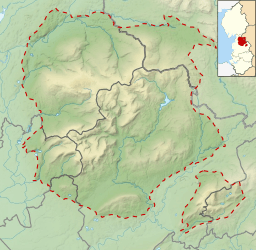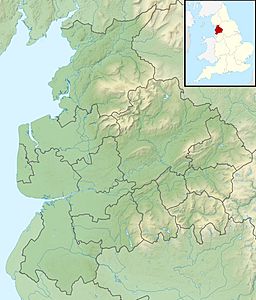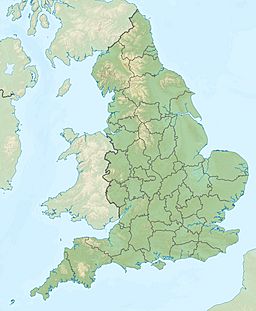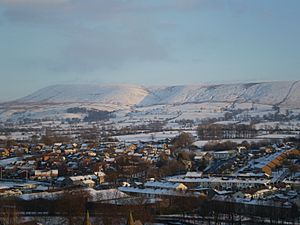Pendle Hill facts for kids
Quick facts for kids Pendle Hill |
|
|---|---|
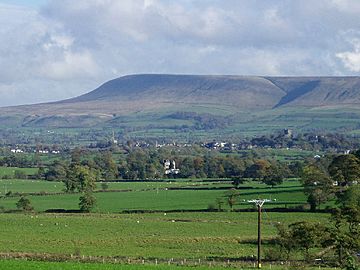
Pendle Hill from the Ribble Valley
|
|
| Highest point | |
| Elevation | 557 m (1,827 ft) |
| Prominence | c. 395 metres (1,296 ft) |
| Parent peak | Kinder Scout |
| Listing | Marilyn |
| Geography | |
| Location | Lancashire, England |
| OS grid | SD804414 |
| Topo map | OS Landranger 103 |
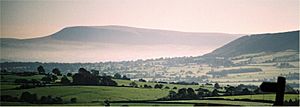
Pendle Hill is a famous hill in the east of Lancashire, England. It is close to towns like Burnley, Nelson, Colne, Clithero, and Padiham. The top of the hill is 557 meters (about 1,827 feet) above sea level. The hill is so important that it gave its name to the local area, the Borough of Pendle. Pendle Hill stands out from other hills in the Pennines mountain range. It is also part of the beautiful Forest of Bowland Area of Outstanding Natural Beauty.
Contents
The Story of Pendle Hill
The name "Pendle Hill" is quite interesting because it means "Hill Hill Hill"! In the 1200s, it was called Pennul or Penhul. These words came from two old languages, Cumbric and Old English, both meaning "hill." Later, people added the modern English word "hill" because they forgot what "Pendle" originally meant.
Scientists have found an ancient burial site from the Bronze Age right at the top of Pendle Hill. This shows that people have lived and used this hill for thousands of years!
The hill is also well-known for three important events that happened in the 1600s:
- The famous Pendle witch trials in 1612.
- Richard Towneley's experiment with a barometer in 1661.
- A special vision seen by George Fox in 1652. This vision led to the start of the Religious Society of Friends (also known as the Quaker) movement.
The Quakers and Pendle Hill
In his own story, George Fox wrote about his experience on Pendle Hill in 1652. This was when the Quakers were just beginning.
As we travelled, we came near a very great hill, called Pendle Hill, and I was moved of the Lord to go up to the top of it; which I did with difficulty, it was so very steep and high. When I was come to the top, I saw the sea bordering upon Lancashire. From the top of this hill the Lord let me see in what places he had a great people to be gathered.
—George Fox: An Autobiography, Chapter 6
Because of George Fox's vision, Pendle Hill is still important to Quakers today. There is even a Quaker center called the Pendle Hill Quaker Center for Study and Contemplation near Philadelphia, Pennsylvania, named after the hill.
Witches and Spooky Tales
The story of the Pendle witches is one of the most famous tales of people accused of witchcraft in England during the 1600s. Even today, the hill is still connected to these stories. Many visitors climb the hill every Halloween. However, in recent years, officials have asked people not to gather in large groups there.
The area is also popular with ghost hunters. The TV show Most Haunted visited Pendle Hill for a live investigation on Halloween in 2004. The show's host, Yvette Fielding, said it was the scariest episode they had ever made!
Pendle Hill and the surrounding area have also inspired books and TV shows:
- The classic 1951 book Mist Over Pendle by Robert Neill.
- The fourth book in Joseph Delaney's The Wardstone Chronicles series, called The Spook's Battle.
- An episode of the British science fiction TV show Doctor Who called "The Witchfinders" takes place during the 17th-century Pendle witch trials.
To celebrate the 400th anniversary of the witch trials, a local artist named Philippe Handford created a huge art piece. He spelled out '1612' on the side of Pendle Hill using 1,500 meters (about 4,900 feet) of special fabric.
How Pendle Hill Was Formed
Hill Shape and Water
Pendle Hill stands apart from the main group of hills in the Forest of Bowland. The River Ribble flows between them. This is why Pendle Hill is considered a "child summit" of Kinder Scout, which is a much taller hill far away in the Peak District. This means Pendle Hill is a very noticeable landmark on its own.
Several streams start on Pendle Hill. Pendle Water begins near the top and flows through a valley called Ogden Clough. It eventually joins the Lancashire Calder near Burnley. Other streams, like Sabden Brook, drain the lower parts of the hill. Mearley Brook and its smaller streams flow down the northwest side of the hill directly into the River Ribble.
Rocks and Landslides
The flat top of Pendle Hill is made of a type of rock called Pendle Grit. This is a rough sandstone that formed during the Carboniferous period, millions of years ago. Underneath this grit are thick layers of Carboniferous Limestone. In fact, a specific time period in geology, called the 'Pendleian', is named after Pendle Hill because of the rocks found here!
The lower slopes of the hill are covered in thick layers of glacial till, also known as boulder clay. This material was left behind by huge sheets of ice during the last Ice Age. Over time, a type of moss called sphagnum grew on the hill and decayed, creating a layer of peat on the surface.
The eastern and southern sides of Pendle Hill are very steep. Because of this, there have been several landslides over the years, where large amounts of earth and rock slide down the slopes.


